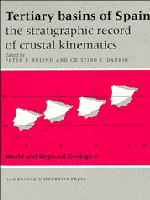Preface
Published online by Cambridge University Press: 04 August 2010
Summary
Reasons for this book
In recent years, much high quality geological work of international interest has been carried out in Spain. This book has been prepared in order to bring together one aspect of this work for the first time, and make it available in the English language.
Studies of outcrop geology depend critically on the quality of the outcrops available, and Spain is very fortunate in this respect. Limited vegetation and weathering reflecting the relative aridity of much of the climate, are combined with topographic incision reflecting the relatively high elevation of much of the country, to produce exposure quality which is some of the best in Europe.
The chapters that make up this book will fully demonstrate the exceptional interest of the Tertiary sedimentary record of Spain. Here we shall simply point out that for a ‘middle-sizedrsquo; country (about 800 km square), Spain has a very wide range of Tertiary geological features, covering two distinct orogenic belts, with the intervening craton, and bounding continental margin structures. The sedimentary basins provide much of the best evidence for the evolution of these major features. The basins range widely in size, and have formed under orogenic loading, compression, extension, transpression and transtension. Clear examples of all these basins will be found in this book.
Organisation of this book
The book opens with a General section, which has been designed to provide necessary background, and review material to introduce the relevant geology for Spain as a whole.
- Type
- Chapter
- Information
- Tertiary Basins of SpainThe Stratigraphic Record of Crustal Kinematics, pp. xiii - xivPublisher: Cambridge University PressPrint publication year: 1996



